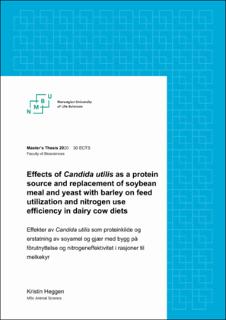| dc.contributor.advisor | Prestløkken, Egil | |
| dc.contributor.author | Heggen, Kristin | |
| dc.date.accessioned | 2021-01-28T12:41:35Z | |
| dc.date.available | 2021-01-28T12:41:35Z | |
| dc.date.issued | 2020 | |
| dc.identifier.uri | https://hdl.handle.net/11250/2725195 | |
| dc.description.abstract | An increasing global population requires increasing sustainable food production. Today, protein from soybeans is used in concentrates to dairy cows. Climatic conditions make it difficult to grow soybeans and other protein crops in Norway, and most protein ingredients are imported. New protein ingredients are developing from sustainable resources such as yeast from lignocellulosic biomass from forests.
The aim of this study was to evaluate Candida utilis as a protein source in diets of high-yielding dairy cows. In addition, the aim was to study the effects of reducing protein content in the diet by replacing soybean meal and yeast with barley. The effects evaluated were milk production, digestibility and nitrogen use efficiency. Forty-eight NRF dairy cows were fed one out of three treatments for a 56-days experimental period. Three diets differing in basic protein source were studied. The diets were soybean meal (SOYABP), C. utilis yeast (YEASTP) and a negative control with less protein (BARLEY). The two last weeks preexperimental all cows were fed SOYABP and registrations were used as covariates for milk, feed intake and body weight in the statistical analysis. Acid-Insoluble Ash was used as an internal marker to determine digestibility based on faecal samples taken the last experimental week.
No significant effect of replacing soybean meal with C. utilis as a protein source was found on dry matter intake, milk production, digestibility or nitrogen use efficiency. Results indicated lower milk protein and milk urea in the barley-based diet compared with the average of soybean meal and yeast. Barley-based diet indicated a decrease in milk and energy corrected milk yield towards the end of the experiment. Urinary N output was lower in the barley-based diet, but no large difference in nitrogen use efficiency was observed. To conclude, replacing soybean meal with C. utilis showed promising results in dairy cows. Feeding diets with lower protein concentration can reduce urinary N emission to the environment. | en_US |
| dc.description.abstract | Stadig befolkningsvekst i verden krever økning i bærekraftig matproduksjon. I dag er protein fra soyabønner brukt i kraftfôr til melkekyr. Klimaet i Norge gjør det vanskelig å dyrke soya og andre proteinvekster og mesteparten av proteinråvarene til husdyr er importert. Nye proteinråvarer som for eksempel gjær fra ligno-cellulose er under utvikling. Vi har rikelig tilgang på ligno-cellulose fra skogen og dette vil kunne bidra til økt selvforsyning og mer bærekraftig matproduksjon. | en_US |
| dc.language.iso | eng | en_US |
| dc.publisher | Norwegian University of Life Sciences, Ås | en_US |
| dc.rights | Attribution-NonCommercial-NoDerivatives 4.0 Internasjonal | * |
| dc.rights.uri | http://creativecommons.org/licenses/by-nc-nd/4.0/deed.no | * |
| dc.title | Effects of Candida utilis as a protein source and replacement of soybean meal and yeast with barley on feed utilization and nitrogen use efficiency in dairy cow diets | en_US |
| dc.title.alternative | Effekter av Candida utilis som proteinkilde og erstatning av soyamel og gjær med bygg på fôrutnyttelse og nitrogeneffektivitet i rasjoner til melkekyr | en_US |
| dc.type | Master thesis | en_US |
| dc.subject.nsi | VDP::Landbruks- og Fiskerifag: 900 | en_US |
| dc.description.localcode | M-HV | en_US |

